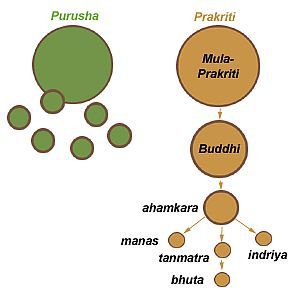Apart from being a book of Mantras, The Devi Mahatmyam is also considered to be an esoteric text on Yoga sastra. The gunas mentioned are as Samkhya-Yoga mentions.
As per this view, Prakrti (Nature) is the primal material constituent. Whilst The Devi Mahatmyam accommodates the Samkhyan view, the view of Prakrti is unique in that it conceptualizes the material world Itself as Supremely Divine, identifying with The Goddess Herself. In spite of certain differences, the Tantric concept of Shiva and Shakti is similar to that of Purusha and Prakriti in Samkhya, or Brahman and Maya in Advaita.
- As per the Samkhyan view Purusha is inert while Prakrti is ever changing.
- Prakrti is productive (prasava-dharmi) because of the ‘Gunas’, which are the modes of being and are relatively objective, ultimate constituents of experience.
- Prakrti is constituted by three modes or qualities (gunas) – Sattva, Rajas and Tamas.
- At the level of Moola Prakrti (Undifferentiated original state of Prakrti) the three gunas are in equilibrium. The moment this equilibrium is disturbed, the gunas are thrown out of balance leading to an unremitting cycle of changes or evolution.
- Mahat which is the first evolute of Prakrti, consists of the three gunas in a constant state of disequilibrium.
- Sattva is characterized by brilliance, knowledge, equanimity and lightness.
- Rajas is characterized by movement, dynamism, ambition, attachment and reactivity or raga. Tamas is characterized by ignorance, delusion and inertia, the power of resistance.
The entire manifest world is subject to the influence of the three gunas.


